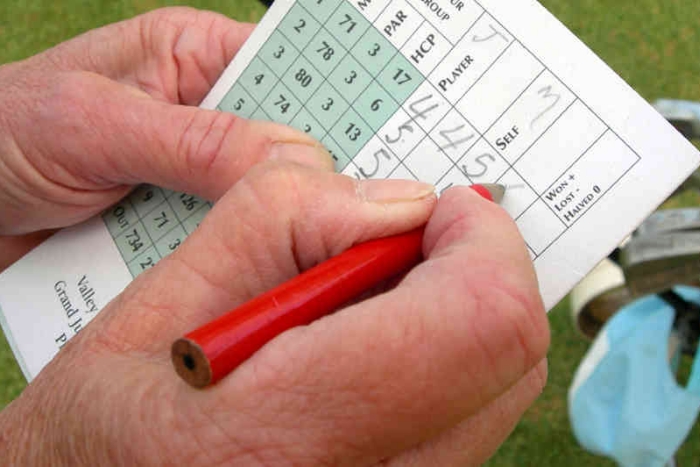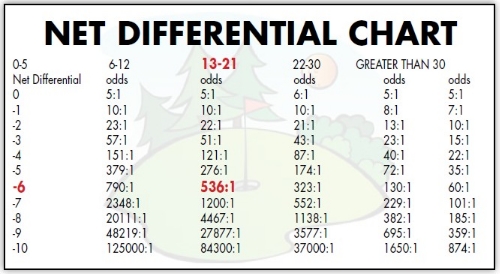
Written by Scott Dunford
For those of us who play amateur tournaments and have an established handicap, course and slope ratings play a major role in determining whether we win or lose. They provide the analytics necessary to give all golfers an equal chance to win if they’re playing above or at their own personal abilities. It works very well unless you have someone who knowingly abuses it. That person is called a sandbagger.
Generally, a sandbagger inflates his handicap index by selectively leaving out his best rounds of golf or consciously mishits a shot when he knows he’s not going to win the hole, adding an additional stoke to an otherwise easy bogey, as an example.
Sandbagging isn’t unique to golf. It happens in bowling, and other sports using a handicap system. You’re a sandbagger when you’ve manipulated your skill level to increase your chances of winning. The lowest of lows in golf course etiquette is to be called out as a sandbagger. So how can you, as an honest golfer, flush them out?
Your club pro is your best offense. They don’t want sandbaggers in their tournaments, because it impacts the interest level and bottom line when participation is affected. Who wants to play when someone has a dishonest advantage right from the start?
First, let’s define slope and course rating, and how they’re determined. Then we’ll talk about how tournament directors detect excessively low scores and what tools they use to illustrate and enforce corrective measures.
Slope is a numerical value ranging from 55-155 that bases the difficulty of the course to a non-scratch golfer. For example, let’s say Player A and Player B average 82 strokes each for 18 holes at Conestoga. Player A’s average is established at Conestoga on the blue tees at a 142 slope, while Player B’s average is established on a much easier course, such as SunRiver, with a slope rating of 117 from similar tees. If handicaps were simply estimates of golfers’ average scores, these players would have the same handicap index.

But thanks to the slope rating system, Player A is given a lower handicap than Player B. If both players shot an 82 on Conestoga, Player B would win with their higher handicap.
Course rating is a value relating to the difficulty of the course to a par golfer.
Slope and course rating also allow golfers to go to different courses and adjust their handicap index up or down depending on the difficulty of each course played. When you post your score, you’ll be asked to identify the course, which tees you played and that course’s slope and course rating. Luckily, we don’t have to do the math thanks to GHIN.com, or guys like me would be making mistakes all the time!
Slope and course rating are calculated for a golf course on the basis of a visit from the USGA rating team. The team spends time with the facility’s staff going over the course hole by hole, taking measurements and reviewing hazards, elevation changes, fairway widths, and so on. Based on the information gleaned during their visit(s), the course rating and slope are calculated, certified by the appropriate overseeing golf associations, and given to the club, which then posts the ratings on its scorecard and elsewhere.
The USGA rating team also goes over the course with an eye as to how both a scratch golfer and a bogey golfer would play it. A scratch golfer is defined by the USGA as a male who hits his drives an average of 250 yards and can reach a 470-yard hole in two strokes, or a female who hits her drive an average of 210 yards and can reach a 400-yard hole in two strokes (and, of course, plays to scratch).
A bogey golfer is defined by the USGA as a male with a handicap index of 17.5 to 22.4 who hits his drives an average of 200 yards and can reach a 370-yard hole in two strokes, or a female with a handicap index of 21.5 to 26.4 who hits her drives an average of 150 yards and can reach a 280-yard hole in two strokes.
Now, let’s discuss how tournament officials police their bigger amateur events to detect if someone’s score needs to be investigated, and what tools are used to illustrate improbable scoring based on one’s handicap.
The chart below, called the net differential, illustrates the odds of someone posting 1-10 strokes below their handicap. The top bar represents various players’ handicap spreads: 6-12, 13-21, 22-30, and greater than 30. The odds of a player with a 13 handicap shooting a net score that’s less than six strokes below their average is 536 18-hole rounds to one. That’s a really rare day of golf; maybe once in a lifetime.
In a tournament situation, it would probably warrant an investigation and possible disqualification. The other option would be to reevaluate their handicap based on their newfound skill level vs. their stated higher handicap in order to continue to compete in a multiple-day event. Numbers, after all, don’t lie; unfortunately, sandbaggers do.
“It’s important to keep in mind that a player’s handicap is determined by their past 20 scores being utilized in a equation where the 10 best of those 20 scores are used to determine a player’s handicap,” said Adam Schwartz, PGA professional at the Oasis Golf Club in Mesquite.
In other words, you’re going to be busted if you post a ridiculously low net score in competition.
There you have it; how slope and course rating play into your handicap, and how to determine if someone’s taking unfair advantage in order to win. Golf is all about the honor system when no one’s looking. If you play that dishonest card on the golf course, there’s a good chance you may fall victim to other forms of dishonesty in life.
Like a slippery slope, dollars and trophies slip from sandbaggers’ hands one week, and more than likely will slip right back into yours the next. It’s all thanks to the fairness of a universal slope and course rating system accepted everywhere golf is played.
See ya on the links!



